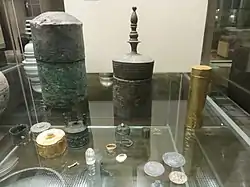Mankiala stupa
The Mankiala Stupa (Urdu: مانكياله اسٹوپ) is a 2nd-century Buddhist stupa near the village of Tope Mankiala, in Pakistan's Punjab province. The stupa was built to commemorate the spot, where according to the Jataka tales,an incarnation of the Buddha called Prince Sattva sacrificed himself to feed seven hungry tiger cubs.[1]
| Mankiala Stupa مانكياله اسٹوپ | |
|---|---|
 The Mankiala stupa is believed to be where an incarnation of the Buddha sacrificed himself in order to feed tiger cubs | |
| Religion | |
| Affiliation | Buddhism |
| Year consecrated | 2rd century CE |
| Location | |
| Location | Tope Mankiala Punjab Pakistan |
| State | Punjab |
 Shown within Pakistan | |
| Geographic coordinates | 33°26′53″N 73°14′36″E |
Location
Mankiala stupa is located in the village of Tope Mankiala, near the village of Mankiala. It is 36 km southeast of Islamabad, and near the city of Rawalpindi. It is visible from the nearby historic Rawat Fort.
Significance

The stupa was built to commemorate the spot, where according to the Jataka tales, the Golden Light Sutra and popular belief, Prince Sattva, an earlier incarnation of the Buddha, sacrificed some of his body parts or his entire body to feed seven hungry tiger cubs.[1][2]
History
The stupa is said to have been built during the reign of Kanishka between 128-151 CE.[3] An alternate theory suggest that the stupa is one of 84 such buildings, built during the reign of Mauryan emperor Ashoka to house the ashes of the Buddha.[3]
The stupa was discovered by Mountstuart Elphinstone, the first British emissary to Afghanistan, in 1808 - a detailed account of which is in his memoir 'Kingdom of Caubul' (1815).[3] The stupa contains an engraving which indicates that the stupa was restored in 1891.
Relics
Mankiala stupa's relic deposits were discovered by Jean-Baptiste Ventura in 1830. The relics were then removed from the site during the British Raj, and are now housed in the British Museum.[4]
Conservation
The stupa has not been restored since 1891, and remains largely abandoned.[3] The stupa features a large defect in its mound, which was created by plunderers.
Access
Mankiala's stupa is located near the Mankiala Road in the village of Tope Mankiala. Towards the west, the Mankiala Road intersects the N-5 National Highway, which provides access to Islamabad and Rawalpindi. The site can also be accessed by the Mankiala railway station in the nearby village of Mankiala, which is served by the Karachi–Peshawar Railway Line.
Gallery
 The stupa in 1897
The stupa in 1897





 Manikyala relics
Manikyala relics Manikyala relics
Manikyala relics Manikyala Kharoshthi inscriptions
Manikyala Kharoshthi inscriptions
See also
- Takht Bahi
- Gandhara
- Taxila
- Dharmarajika Stupa - largest of the stupas which form the Ruins of Taxila.
References
- Bernstein, Richard (2001). Ultimate Journey: Retracing the Path of an Ancient Buddhist Monk who Crossed Asia in Search of Enlightenment. A.A. Knopf. ISBN 9780375400094. Retrieved 16 June 2017.
Mankiala tiger.
- Golden Light Sutra 18.
- "The forgotten Mankiala Stupa". Dawn. 26 October 2014. Retrieved 16 June 2017.
- The British Museum Collection